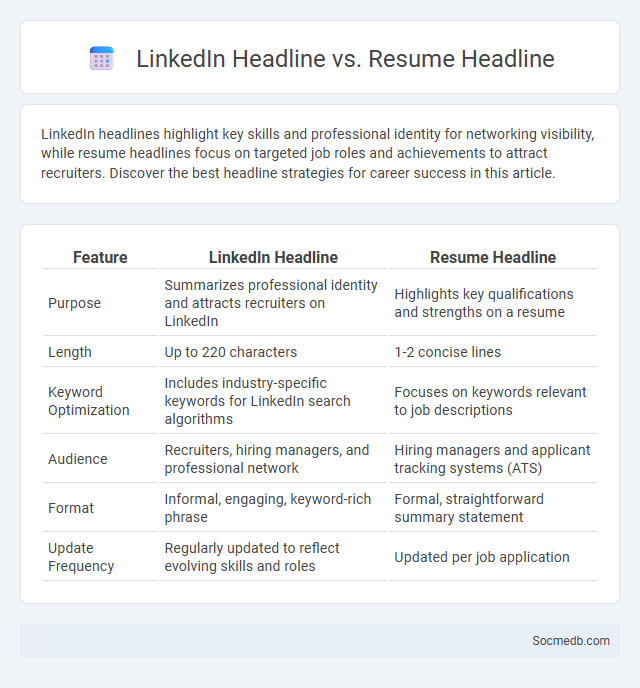
Photo illustration: LinkedIn Headline vs Resume Headline
LinkedIn headlines highlight key skills and professional identity for networking visibility, while resume headlines focus on targeted job roles and achievements to attract recruiters. Discover the best headline strategies for career success in this article.
Table of Comparison
| Feature | LinkedIn Headline | Resume Headline |
|---|---|---|
| Purpose | Summarizes professional identity and attracts recruiters on LinkedIn | Highlights key qualifications and strengths on a resume |
| Length | Up to 220 characters | 1-2 concise lines |
| Keyword Optimization | Includes industry-specific keywords for LinkedIn search algorithms | Focuses on keywords relevant to job descriptions |
| Audience | Recruiters, hiring managers, and professional network | Hiring managers and applicant tracking systems (ATS) |
| Format | Informal, engaging, keyword-rich phrase | Formal, straightforward summary statement |
| Update Frequency | Regularly updated to reflect evolving skills and roles | Updated per job application |
Understanding the Role of Headlines in Your Professional Branding
Headlines play a crucial role in professional branding on social media by immediately capturing audience attention and conveying core expertise. Effective headlines incorporate relevant keywords and clear value propositions that enhance search visibility and attract targeted connections. Crafting compelling headlines aligned with industry-specific terms strengthens personal brand authority and increases engagement across platforms like LinkedIn and Twitter.
What Is a LinkedIn Headline?
A LinkedIn headline is a concise, 220-character summary displayed below your name on your profile that highlights your professional identity and expertise. It serves as a critical element for personal branding and SEO, making it easier for recruiters and potential clients to find your profile. Optimizing your LinkedIn headline with relevant keywords can significantly boost your visibility and impact your professional opportunities.
What Is a Resume Headline?
A resume headline is a concise phrase that summarizes your professional identity and key qualifications, designed to immediately capture an employer's attention. It highlights your expertise and achievements in a few impactful words, making your resume stand out in social media job applications and online profiles. Crafting a clear, tailored resume headline ensures your skills and strengths align with your career goals and the positions you seek.
Key Differences: LinkedIn Headline vs Resume Headline
LinkedIn headlines are crafted to boost your online presence by incorporating keywords that enhance searchability and attract recruiters, while resume headlines focus on succinctly summarizing your professional identity and key skills tailored to specific job applications. Your LinkedIn headline can showcase a blend of your current role, industry expertise, and personal brand, whereas a resume headline strictly targets the job description to highlight relevant experience and qualifications. Understanding these key differences helps you optimize both platforms effectively for career growth.
How LinkedIn Headlines Impact Recruiter Searches
LinkedIn headlines play a critical role in recruiter searches by incorporating targeted keywords that align with industry-specific roles and skills, improving profile visibility. A well-crafted headline succinctly highlights professional expertise, accomplishments, and unique value propositions, increasing the likelihood of appearing in relevant search queries. Optimizing LinkedIn headlines with precise job titles and competencies enhances recruiter engagement and accelerates career opportunities.
Crafting a Powerful Resume Headline
A powerful resume headline on social media platforms like LinkedIn efficiently captures your professional identity and key skills in a concise phrase, increasing visibility to recruiters. Incorporating relevant keywords such as "Digital Marketing Expert," "Data Analyst," or "Project Manager" enhances algorithm-driven search results and engagement. Tailoring the headline to reflect your unique value proposition and industry-specific terms drives higher profile views and networking opportunities.
Resume Optimization: Best Practices for ATS & Human Readers
Maximize your resume's impact by incorporating relevant keywords and phrases tailored to your industry and target job, ensuring it passes Applicant Tracking Systems (ATS) filters. Use clear, concise language with strong action verbs and quantifiable achievements to engage both ATS algorithms and human recruiters. Optimize formatting by avoiding complex layouts or graphics, as ATS software struggles to parse them, while keeping your resume visually appealing for human readers.
Common Mistakes to Avoid in LinkedIn and Resume Headlines
Writing LinkedIn and resume headlines that lack specific keywords relevant to your industry reduces visibility in search results, limiting networking and job opportunities. Headlines that are too generic or vague, such as "Experienced Professional," fail to convey unique skills and value, making them less impactful to recruiters and connections. Avoid overloading headlines with buzzwords or irrelevant information, as this can detract from your core strengths and reduce the effectiveness of your personal brand.
Tips for Aligning Your LinkedIn and Resume Headlines
Craft LinkedIn and resume headlines with consistent keywords such as industry-specific skills, job titles, and expertise to enhance visibility in recruiter searches. Incorporate quantifiable achievements and professional branding phrases to convey value and attract targeted opportunities. Optimize headlines by using action-oriented language and maintaining alignment with your career goals for maximum impact.
Maximizing Opportunities with Optimized Headlines and Resumes
Optimizing your social media headlines and resumes significantly boosts visibility and engagement, attracting potential employers and collaborators. Craft headlines with targeted keywords and clear value propositions to enhance your profile's searchability and appeal. Tailor your resume content to reflect relevant skills and achievements, ensuring it resonates with your audience and maximizes your professional opportunities.
 socmedb.com
socmedb.com